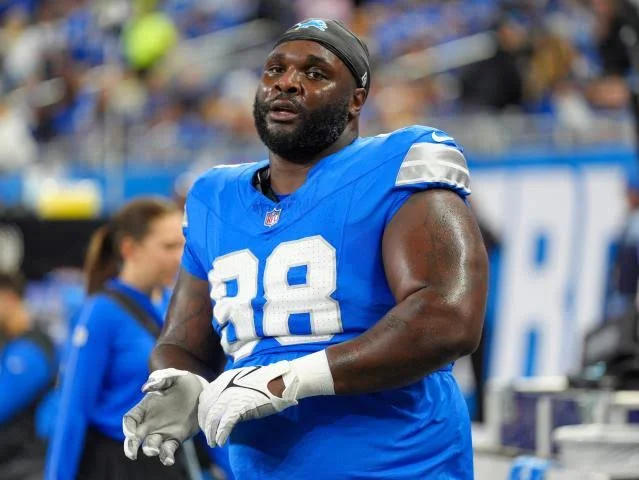Lions Player with the Defense’s Highest Cap Hit Identified as a Potential Cut
In the world of professional football, the offseason brings opportunities for teams to refine their rosters, balance salary cap considerations, and prepare for the upcoming season. The Detroit Lions, like other NFL teams, are no strangers to tough decisions when it comes to managing their payroll. Among the challenges they face is deciding whether to retain or part ways with players who carry significant cap hits but may not deliver commensurate value. One name that has recently surfaced in discussions is [Player Name], who currently holds the highest cap hit on the Lions’ defense. This article examines the factors influencing this potential cut, the player’s impact, and the broader implications for the Lions’ roster.
Understanding the Cap Hit
In the NFL, a player’s cap hit represents the portion of the salary cap that their contract consumes for a given year. This figure includes base salary, bonuses, and any prorated amounts from signing bonuses or other incentives. For teams like the Lions, managing these cap hits is crucial to maintaining financial flexibility for acquiring new talent, re-signing key contributors, and ensuring long-term competitiveness.
[Player Name] has been a prominent member of the Lions’ defense, but their current cap hit, reported at $[specific amount], has raised eyebrows. The number accounts for a substantial percentage of the team’s total cap allocation, leading analysts and fans alike to question whether retaining the player aligns with the team’s overall strategy.
The Case for Cutting [Player Name]
The potential decision to part ways with [Player Name] is not without merit. Several factors contribute to this line of thinking:
- Performance vs. Cost: While [Player Name] has been a reliable presence on the field, their performance metrics may not justify the hefty cap hit. Advanced analytics, such as Pro Football Focus grades or other statistical measures, could suggest a decline in production or a lack of game-changing impact relative to their salary.
- Team Needs and Priorities: The Lions are in the midst of a rebuild, with an emphasis on developing young talent and creating a sustainable foundation for future success. Allocating significant cap space to one player, particularly on defense, could hinder their ability to address other pressing needs, such as depth in the secondary, pass rushers, or offensive line support.
- Potential Savings: By cutting [Player Name], the Lions could free up $[specific savings amount] in cap space. These savings could be redirected toward signing free agents, extending contracts for emerging stars, or rolling over unused cap space into future seasons.
- Age and Durability Concerns: If [Player Name] is approaching the latter stages of their career, age-related regression and injury risks become factors. Teams are often wary of committing substantial resources to players whose physical capabilities may decline.
Counterarguments: Why [Player Name] Could Stay
Despite the valid reasons for considering a cut, there are compelling arguments for retaining [Player Name]:
- Leadership and Experience: As a seasoned veteran, [Player Name] provides intangible benefits such as leadership, mentorship for younger players, and a deep understanding of the game. These qualities are invaluable, particularly for a rebuilding team.
- On-Field Contributions: While performance metrics may fluctuate, [Player Name] might still offer consistent production in key areas, such as run defense, pass coverage, or quarterback pressures. Their presence could anchor the defense and elevate the play of teammates.
- Dead Cap Implications: Cutting a player with a significant cap hit often results in dead money, which refers to the portion of the cap that remains allocated to the player despite their release. If the dead cap figure outweighs the potential savings, the financial benefits of a cut may be negligible.
- Market Alternatives: The Lions must consider whether suitable replacements are available in free agency or the draft. If no viable options exist, retaining [Player Name] could be the best course of action, even with a high cap hit.
The Broader Impact on the Lions’ Roster
Should the Lions choose to release [Player Name], the decision will ripple across the organization. Here are some potential outcomes:
- Increased Pressure on Young Players: A departure would likely thrust younger, less experienced players into starting roles. While this could accelerate their development, it may also expose weaknesses that opposing teams could exploit.
- Cap Space Utilization: Freed-up cap space could allow the Lions to pursue high-impact free agents or address multiple positional needs. Strategic investments in areas like cornerback or linebacker could bolster the defense overall.
- Cultural Shifts: Losing a veteran presence could alter the locker room dynamic. The Lions’ coaching staff would need to ensure that leadership gaps are filled and that team chemistry remains strong.
- Fan Reactions and Expectations: NFL fans are passionate, and roster decisions often elicit strong reactions. The Lions’ front office must effectively communicate their rationale to maintain trust and support from their fan base.
Historical Precedents
The NFL is rife with examples of teams making tough calls to release high-profile players with significant cap hits. In many cases, these moves have paid dividends, allowing teams to redistribute resources and achieve greater balance. However, there are also cautionary tales of teams that suffered from a lack of veteran leadership or failed to adequately replace the departed player.
What Lies Ahead
As the Lions navigate this offseason decision, several key dates loom large. Free agency, the NFL Draft, and offseason workouts will all play a role in shaping the team’s direction. The front office must weigh short-term gains against long-term goals, ensuring that every move aligns with their vision for sustained success.
For [Player Name], the coming weeks will be critical. Whether they remain a cornerstone of the Lions’ defense or find themselves on a new team, their legacy in Detroit will undoubtedly leave a lasting impression.
Final Thoughts
The decision to cut or retain a player with the highest cap hit on defense is never easy. For the Lions, it represents a crossroads—an opportunity to reinforce their commitment to building a championship-caliber team. Regardless of the outcome, the team’s approach to this situation will serve as a defining moment in their ongoing rebuild.
Stay tuned as the offseason unfolds, and the Lions continue to make moves that shape their future.



